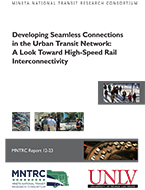Abstract:
In the past, U.S. studies on high-speed rail (HSR) have focused primarily on the economic implications of high-speed rail development. Recently, however, studies have begun evaluating multimodal connectivity of HSR stations. The ways in which different modes are connected to HSR stations influences the ridership of HSR. As the development of the U.S. HSR system has reached the stage of design and construction, guidelines on multimodal connectivity are necessary to maximize that ridership.
The objective of this study was to quantify multimodal connectivity of HSR stations and its impact on ridership in four countries where HSR has been established, setting the basis for future rail interconnectivity. In this study, multimodal connectivity is measured by the number of different modes of transportation connected to HSR stations, the number of installed arrival and departure facilities for each mode, the transfer time from connecting modes to boarding platforms at HSR stations, and the arrival time intervals of public transportation modes. To achieve this objective, data were collected from HSR systems of France, Spain, Japan and China. Various characteristics of the connecting modes were observed and compared. The relationship between ridership and the characteristics of multimodal connectivity was identified using regression models developed in this study.
It was observed from the analysis that the multimodal connectivity at HSR stations in various countries presents a variety of profiles. For example, HSR stations in China connect with more bus lines than those in other countries. Relatively, there are more bus stops/terminals provided in France. Transfer times in Japan and China are significantly longer than those in France and Spain. The average bus arrival interval in France is longest, at more than double that in China.
All the connectivity variables considered in this study influence ridership in these four countries in various ways. On the whole, bus, subway, and regional railroad service influence ridership significantly. For instance, the more bus services connected to the station, the higher the ridership. This trend is apparent in three of the four countries, France being the exception. Also, subway, light rail, and traditional rail are modes of high-capacity transportation. Their connection to HSR stations always implies high ridership for high-speed rail. The number of facilities also shows significant impacts on HSR ridership. For instance, the more bus and subway stops, and the more bicycle parking and taxi stands, the higher the ridership. Transfer time also has a significant influence.
These findings have important implications for the proposed California and Nevada HSR stations. Accommodations for arrival on foot or by bicycle are recommended. More issues on transfer time at HSR stations in the metropolitan areas in California are elaborated upon. Also discussed are the unique needs of visitors to Las Vegas and their implications for HSR design.
Publications:
Authors:
HUALIANG (HARRY) TENG, PH.D.
Dr. Teng, an Associate Professor in Transportation Engineering at the University of Nevada, Las Vegas (UNLV), has approximately 30 years of research and education experience in transportation engineering and management. He graduated from China’s Beijing Jiaotong University with his B.S. and M.S. degrees in railroad engineering and management. He has a second M.S. degree from West Virginia University on railroad operations, and a Ph.D. in civil engineering from Purdue University. He has taught at Beijing Jiaotong University, Polytechnic University of New York, The University of Virginia (UVa), and UNLV. He was the Associate Director for the Center of Transportation Studies at UVa.
Dr. Teng leads the railroad and high-speed rail program at UNLV. Currently, he is operating the Transit UTC at UNLV for which he has been involved in research with federal and local agencies and organized distinguished seminars. He has initiated the railroad, high-speed rail, and transit program at UNLV for which he has developed a curriculum and certificate program on railroad. He is the advisor for the AREMA student chapter at UNLV. In addition, he has been active in railroad professional activities.
Dr. Teng also is interested in Intelligent Transportation Systems, infrastructure maintenance, air quality analysis, freight transportation, safety, and demand forecasting. So far, he has published approximately 40 peer-reviewed technical papers.
TARIK TOUGHRAI
A graduate Student of School of Engineering at the Ecole Nationale des Travaux Publics de l’Etat, Lyon, France, Tarik Toughrai was an intern at the University of Nevada, Las Vegas, when he worked on this research project.
TINGTING YU
Tingting Yu is pursuing a M.S degree in Civil Engineering at the University of Nevada, Las Vegas. She obtained her B.S. degree of Economics from Wuhan University in China.
RUSSELL OZAWA
Russell Ozawa graduated from the University of California at Davis (UCD) with a B.S. degree in civil engineering and a minor in Japanese. He also graduated from the University of Nevada, Las Vegas (UNLV), with an M.S. degree in civil engineering. Prior to obtaining his M.S. degree, he worked at Miyamoto International, Inc. in Los Angeles, California, for several years as a project engineer. Miyamoto International is a global structural and earthquake engineering private firm.
Mr. Ozawa is currently helping Dr. Teng at UNLV in the research of high-speed rail station multimodal connectivity. He has been researching the high-speed rail systems of Japan.
His research interests include high-speed rail systems, transportation systems, structural engineering design, as well as sustainability construction and design.
BINGYI HU, PH.D.
Bingyi Hu is an Associate Professor in the School of Computer Science at Beijing Jiaotong University, Beijing, China. He obtained his Ph.D. degree from Tsinghua University. Dr. Hu has developed a railway information network for a railway bureau in China. He has been working in the chief engineer office of Xi’an railway bureau for over a year and is familiar with railway information exchange among departments. His research interests include information sharing and network construction.
In addition, Dr. Hu is also interested in device design and development. He has designed more than ten devices and systems and holds more than 30 patents from China. These designs are related to medical instruments and monitoring device of railway systems.


